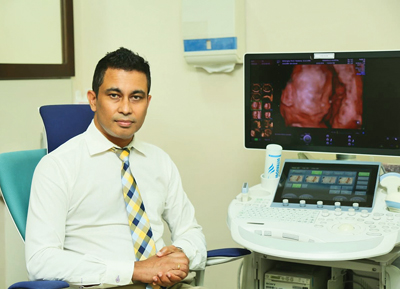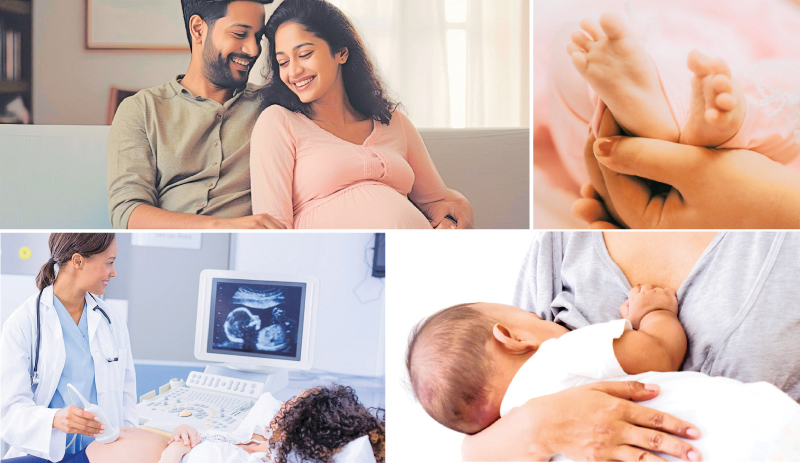Pregnancy is a time of joy and happiness. The couple should be able to look forward to the arrival of the baby, with anticipation and exhilaration. It is a natural event in the life of a woman and, therefore, should be treated as such. Unfortunately, many couples are filled with anxiety and apprehension, engendered by myths and misconceptions generated by family and friends. We asked Consultant Obstetrician and Gynaecologist Dr. Vijith Vidyabhushana to clear the air about a few such matters.
Pregnancy sometimes doesn’t feel entirely real until you have that first peek at your baby during your first prenatal ultrasound. Fortunately, pregnancy ultrasounds are a very standard — and very welcome — part of prenatal care today.
Sound waves
Ultrasound basically deals with sound waves which cannot be detected by human ears. It is a noninvasive imaging test that shows structures inside your body using high-intensity sound waves. Healthcare providers use ultrasound exams for several purposes, including during pregnancy, for diagnosing conditions and for image guidance during certain procedures.
 “A human ear can detect 20 to 20,000Hz. The frequencies used for medical ultrasounds can range from 2 to 20Hz. The history of ultrasound can be traced back to more than 40 years. It is found to be safe in pregnancy. Ultrasound enables healthcare providers to “see” details of soft tissues inside your body without making any cuts,” Dr. Vidyabhushana explained.
“A human ear can detect 20 to 20,000Hz. The frequencies used for medical ultrasounds can range from 2 to 20Hz. The history of ultrasound can be traced back to more than 40 years. It is found to be safe in pregnancy. Ultrasound enables healthcare providers to “see” details of soft tissues inside your body without making any cuts,” Dr. Vidyabhushana explained.
During an ultrasound, a healthcare provider passes a device called a transducer or probe over an area of your body or inside a body opening. The provider applies a thin layer of gel to your skin so that the ultrasound waves are transmitted from the transducer through the gel and into your body. The probe converts electrical current into high-frequency sound waves and sends the waves into your body’s tissue. Sound waves bounce off structures inside your body and back to the probe, which converts the waves into electrical signals. A computer then converts the pattern of electrical signals into real-time images or videos, which are displayed on a computer screen nearby.
Today, abdominal as well as transvaginal ultrasounds are performed. Transvaginal ultrasounds are normally done at the early stages of pregnancy. It is totally painless.
“You can dub an ultrasound as the foundation of a pregnancy. It is vital and essential investigation in pregnancy according to medical evidence. We calculate the expected date of delivery by assuming that an egg that has been released two weeks after the last menstrual period (LMP) has been conceived on the same day. We add 40 weeks or 280 days to the last menstruation. We clarify this through an early scan. We have based these findings from In vitro fertilisation (IVF) pregnancies where we know the exact date of conception. Therefore, we know the exact date of delivery of a IVF,” Dr Vidyabhushana pointed out adding that those data were helpful in determining the measurements of a fetus during the course of pregnancy.
“For example, during eight weeks the length of a baby has to be 16mm. At nine weeks it should be 23mm and at 10 weeks it should be 30mm. If someone is 10 weeks from last menstruation, we do a scan and access the length from head to bottom which is called crown rump length (CRL). If the CRL is 30mm, then we know for sure that this is around 10 weeks. If the length of the baby is 23mm, then we know that it is nine weeks into the pregnancy. This way we determine the expected date of delivery. This is why it is also called the dating scan,” he said adding that a scan needs to be done from 10 to 14 weeks to access the CRL.
“Factors like checking to see if the foetuses’ growth is adequate can also be done via an ultrasound. It Is also important to do a scan early on in the pregnancy to see if the fetus is placed inside out outside the womb, if it is viable, and if the heartbeat can be located. At the time of the dating scan, which is done at 12 weeks, we also look for abnormalities. The risk of down syndrome can also be determined then,” he said.

Consultant Obstetrician and Gynaecologist
Dr. Vijith Vidyabhushana
Queried if any preparations need to be done before undergoing an ultrasound and Dr. Vidyabhushana says it is better to have a full bladder early in the pregnancy for a transabdominal scan. He urges the mothers-to-be to drink plenty of water as it aids digestion and helps form the amniotic fluid around the foetus. However, for a transvaginalscan one needs to have an empty bladder.
Pregnancy might seem like the perfect time to sit back and relax. You may feel more tired than usual, your back might ache and your ankles might be swollen. But there’s more to pregnancy and exercise than skipping it entirely.
There are numerous potential health benefits for women who exercise during pregnancy, including better weight control. As long there are no complications, you should be able to continue with most exercises you did before getting pregnant. There are lots of types of exercise that are safe to do in pregnancy, including walking, yoga, running, swimming, pilates and more.There is evidence that active women are less likely to experience problems in later pregnancy and labour. Regular exercise can help your body adapt to the changes that occur during pregnancy. Exercise reduces constipation, bloating, swelling and backaches. Physical activity improves mood, posture, muscle tone, strength and endurance. It may also help you sleep better.
Exciting time
The last few days of pregnancy are an exciting time. But when your due date has passed, waiting for labor to start can be stressful too. Many parents-to-be become anxious. If there are no specific problems, the baby is probably doing fine.
“According to medical evidence the average gestational age of humans is 40 weeks from the last menstruation. It is just an average. Some deliver at 40 weeks while there are preterm and premature deliveries too. If you take 100 women, around 60 will deliver on or before the given due date while about 40 can go beyond that. Out of these around 15 would not go into labour even two weeks after the expected date of delivery. According to medical evidence in developed countries, what they do is they wait for seven days until they go into labour spontaneously.
On the seventh day they offer induction which means starting the labour artificially,” he said adding that waiting for natural labour is the best step to take. Induction has to be done only if someone does not go into labour naturally. It will be done before the due date only if the doctor thinks continuing the pregnancy will be hazardous for the mother or the baby.
Many women believe that once they have delivered a baby by Caesarean section, or C-Section, they will have to schedule a C-Section for their future pregnancies. This is not always the case. A Vaginal Birth after a Caesarean (VBAC) is an option for many women. Depending on your health history, the reason for the initial C-Section, and C-Section scar location, your doctor may give the “OK” to try VBAC.
“It is possible but you need to understand that there is a scar in the womb. Thisscar can rupture when they go into labour. About 50 per 10,000 women can end up having scar rupture which will cause problems for the mother as well as the baby. As long as the parents-to-be understand and are ok to undertake that risk, and as long as the mother-to-be is not suffering from any other complications, then it is fine to go for a VBAC,” Dr. Vidyabhushana said.
Some women experience health problems during pregnancy. These complications can involve the mother’s health, the foetus’ health or both. Even women who were healthy before getting pregnant can experience complications. These complications may make the pregnancy a high-risk one.
“High-risk” pregnancy
A “high-risk” pregnancy means a woman has one or more things that raise her — or her baby’s — chances for health problems or preterm (early) delivery. “If someone is having diabetes, high blood pressure, pregnancy induced high blood pressure or any other medical disorders or if the foetus has growth restrictions, if the placenta is situated in the lower part of the womb (placenta previa) or if there are multiple babies – these are all considered as high-risk pregnancies. If the pregnancy is complicated by certain factors or if we anticipate problems, then it is basically considered as a high-risk pregnancy,” Dr Vidyabhushana said.
Most moms 35 or older have a normal pregnancy and healthy baby. There are even some advantages to being an older mom, including financial stability and having more life experience that can help during your parenting journey.
Having a baby is a life-changing decision and to each person the experience of pregnancy and childbirth is different. From hormonal changes to emotional breakdowns, pregnancy can be a roller coaster ride for many women and for many, it is a fulfillment of a lifelong dream.









